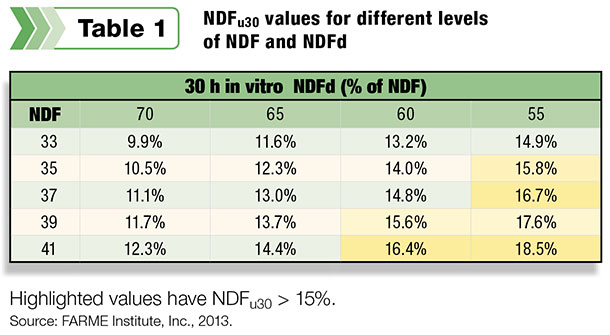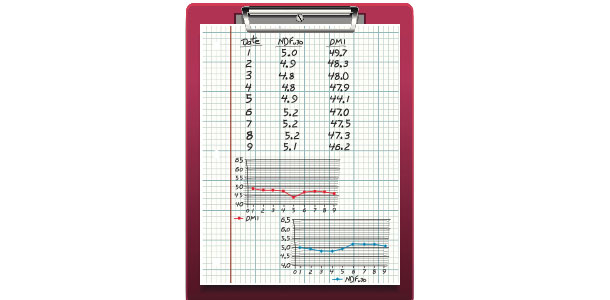Forage is an important ingredient in dairy cattle rations. However, it can be difficult to achieve high intake levels with certain forage-based diets. We have long recognized that NDF digestibility influences intake. In fact, researchers in 1999 made the observation that a one-unit increase in NDF digestibility (NDFd) is associated with 0.37-pound increase in dry matter (DM) intake and 0.55-pound increase in 4 percent fat-corrected milk.
A significant effort has been put forth to characterize NDF digestibility, especially by developers of empirical models that attempt to predict milk production. Common measurements include NDFd, which is the percent of NDF that is digested after a certain period, and Kd, which is the rate (percent per hour) at which NDF is digested. These measures fail to account for the amount of NDF present. We call this the NDF pool.
For example, consider two samples with a 50 percent NDFd, which means after 30 hours of rumen incubation, half the NDF will be digested. The first sample has an NDF pool of 34 percent, which results in a 17 percent digested NDF pool (34 percent x 50 percent).
We interpreted this as meaning 17 percent of the forage DM is digestible NDF. The second sample has an NDF pool of 40 percent, which results in a 20 percent digested NDF pool (40 percent x 50 percent). The second sample with the higher NDF pool will provide a higher digestible NDF pool. Measuring the digestible and undigested NDF pool size is extremely important when characterizing the value of forage.
We have introduced a new approach linking NDF digestibility to dry matter intake which corrects the above oversight. This is the result of a cooperative venture between American Farm Products (Ypsilanti, Michigan) and FARME Institute (Homer, New York). Dr. Joanne Siciliano-Jones, President of FARME Institute, has a long history of studying the fiber digestibility using in situ techniques.
I serve as the forage specialist for American Farm Products, which markets an enzyme- based forage inoculant. Jointly, our interest was to determine the value of fermented forages corrected for their intake potential. In the literature, it is acknowledged that dry matter disappearance (DMD) is related to the NDF pool and its digestibility.
In 2010, the formula that DMD = 87.1 – (0.98 - NDFd) x NDF was published. Since DMD is highly related to gut fill, we concluded that the undigested pool, (1-NDFd) x NDF, is highly related to intake.
Rumen fill, which often limits DM intake, is caused by NDF particles that remain in the rumen for an extended time period. Consequently, we have extended current thinking about NDF to focus on these undigested pools developing a metric called “NDFu30.” NDFu30 is the amount of NDF that remains undigested after 30 hours of incubation, expressed as a percentage of DM.
NDFu30 = NDF x (1 – NDFd30)
Where:
NDFu30 = pounds undigested NDF ÷ pounds DM
NDF = pounds NDF ÷ pounds DM
NDFd30 = pounds digested NDF ÷ pounds NDF
(1 – NDFd30) = pounds undigested NDF ÷ pounds NDF
The major question in measuring the digested NDF pool (i.e., NDFd) is the length of time NDF particles stay in the rumen before they flow out. Based on our experience and values in the literature, a 30-hour in vitro incubation period for NDF best represents the rumen residency time. More important, commercial forage analysis laboratories are providing this determination, which makes it a readily available measurement.
Determining NDFu30 requires estimating forage NDF pool and 30-hour in vitro NDF digestion. Together, NDF digestibility (NDFd) and NDF pool size estimate the undigested NDF pool size (NDFu30). For example, corn silage with 38 percent NDF and a 30-hour in vitro NDFd of 60 percent will have an NDFu30 pool size, which is 15.2 percent of the dry matter.
It is important to notice that the description is “undigested” and not “indigestible.” “Indigestible” indicates that NDF cannot be digested, while “undigested” indicates that in the time allowed NDF was not converted to VFA (volatile fatty acids) and microbial biomass.
From on-farm observations with corn silage-based rations, corn silages with an NDFu30 of 15 percent or less seem to promote high levels of intake. It is also obvious that as forage NDF pool size rises, NDF digestibility must increase to maintain the same NDFu30 pool size.
Biologically, there may be a specific total dietary NDFu30 intake limit. However, this intake may not be realized due to other factors that can impact intake (e.g., particle size, total starch content and palatability of feeds). It is recommended that nutritionists frequently record dry matter intake along with NDFu30 intake to determine the optimal NDFu30 for a group.
Total NDFu30 for a high-producing group of dairy cows will typically range from 5 to 6.5 pounds daily. It is important to include all significant sources of undigested fiber into this calculation. Any ingredient that contributes more than 1 pound of NDF to the diet should be closely examined.

Figure 1 shows the graph over time for a group DM intake and the consumed NDFu30 pool size. This monitoring provides several useful diagnostics. We have seen examples where a new ration was implemented with a higher NDFu30 value but the intake decreased to match the previous NDFu30 pool size.
We interpret this as the new diet violated the intake potential and the DM intake decreased to match the NDFu30 intake potential. Likewise, we have experienced scenarios where both DM intake and NDFu30 decreased, indicating something else other than NDFu30 was suppressing intake (e.g., acidosis, overcrowding).
There are two interesting extensions from knowing the typical NDFu30 group intake. First, given the ration NDFu30 content (percentage of DM), the “NDFu30 Intake Index” can be calculated. Consider a group that seems to stall at 6 pounds of NDFu30. For example, in Figure 1, the NDFu30 intake never goes above 6 pounds.
We would predict that a diet that provides 12 percent NDFu30 will have a maximum intake potential of 50 pounds of DM. We calculate this as 6 NDFu30 pounds divided by 12 percent, which equals 50 pounds of DM. Second, if the group is eating less than its NDFu30 intake potential, other items that limit intake need to be carefully evaluated.
As with any ration program, an incorrect digestibility estimate will result in an incorrect prediction. We fully support routine NDF digestibility measurements given typical error of this measurement.
Despite all the industry discussion of BMR versus conventional corn hybrids for increasing corn silage NDF digestibility, our focus on the NDFu30 reveals that haylage has the largest potential to limit DM intake in most typical diets.
Recent data from Cumberland Valley Analytical Services suggests that corn silage samples (central two quartiles) will have NDFu30 values ranging from 15 to 19 percent, and haylage samples (central two quartiles) will have NDFu30 values ranging from 20 to 27 percent. Management programs that harvest haylage at the correct maturity and rapidly drop pH result in the lowest forage NFDu30 contribution.
The major obstacle of ration balancing is estimating DM intake. Our field observations suggest that NDFu30 intake potential will provide a basis for formulating and evaluating rations that best utilize forages. The concept of NDFu30 is new only in its formalization.
Many recent articles relating to digestible fiber discuss increasing intakes with increasing NDF digestibility; they fail to acknowledge the inverse, which is increasing intakes with decreasing undigestible NDF. We are currently evaluating diets of several high-producing herds to determine factors in addition to NDFu30 that relate to dry matter intake. PD
Lawrence R. Jones is with American Farm Products, Inc. and can be reached by email .
References omitted due to space but are available upon request. Click here to email an editor.







